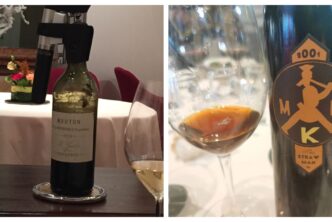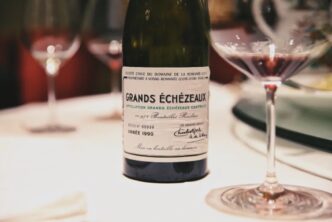Vilmart 2010 Champagne Coeur de Cuvee Brut 97

by Robert Millman
I begin by confessing that I do not have the unbridled passion for Champagne that many wine lovers claim to have. To make matters worse, for me, I tend to liked the more expensive Champagnes. At least for me, far too many relatively inexpensive Champagnes taste like tart wines from underripe fruit buoyed by aggressive bubbles and a nice dosage of sugar syrup. I exaggerate of course. At a recent industry tasting I experienced my pattern once again. After tasting 40 Champagnes or so, I discovered what I already knew: That I have a predilection for the Vilmart Champagnes in general and their Tete de Cuvee in particular–which they call Coeur de Cuvee. The name is not a marketing ploy but rather an indication of how the juice for the product is selected. The Coeur de Cuvee is always offered in Magnum and is generally at least a decade old before being made available to the public.
Anyone following the Champagne market knows that the world has witnessed a proliferation of small-producer Champagnes which has surpassed anyone’s wildest expectations. Keeping up with all these limited production Champagnes is a full-time occupation. It can hardly be claimed that Vilmart is part of this influx. It meets the criterion of small—making about 9000 cases annually. But Vilmart owes it origins to the late nineteenth century. The first commercial release dates back to 1890, one hundred years before the explosion of grower Champagnes began to mushroom.
There is a unique feature to the Vilmart holdings which in part explains the distinction of their Champagnes. All their vineyards are in the town of Rilly-la -Montagne in the Montagne de Reims, a subregion known for its exceptional Pinot Noirs; and yet, Vilmart’s grape blend composition is 60% Chardonnay and 40% Pinot Noir. Most of their final bottling are between 70 and 80% Chardonnay. This synthesis of Chardonnay brilliance and Pinot Noir richness, if not unique, is unsurpassed by any other estate, small medium or large. Laurent Vilmart, the fifth generation of his family, runs the 25 acres estate with consummate skill. He experimented with biodynamics in the late 1980s but now employs a range of certified vineyard techniques which all maintain a sustainable approach to every aspect of vineyard management. For Laurent flexibility is the key to a region which sees more than its share of climate variability. All the wines begin with fermentation in older Burgundy barrels for 10 months. Malolactic is blocked to preserve the freshness and energy central to successful Champagne. It is the high acidity of the juice which itself prevents malo from occurring. The fruit is placed in a vertical press which secures the purity of the juice. Every Champagne I have tasted from Vilmart is both pleasing and satisfying—from the affordable Grande reserve NV to the top-of-the-line Coeur de Cuvee. Laurent and his team exclude the first 200 and the final 500 liters of the pressed juice. The vines for the Coeur are very old and the wine is aged sur lie for 66-72 months before bottling. I am pleased to report the Vilmart uses a low dosage of 6-7 grams per liter. Many readers are aware of the current for fashion for no-dosage Champagnes. This is based in the belief that even a small amount of sugar obscures terroir specificity. I have little tolerance for this ideologically-based conviction. With its very high acidity and low alcohol a discrete addition of sugar imparts a welcome, even necessary roundness to Champagnes. Outstanding terroir cannot be obscured by a small addition of sugar any more than the character of a sauce can be obscured by just the right addition of salt. Sugar and salt used appropriately enhance flavor and expression.
What a profound and exciting bubbly the Vilmart 2010 Champagne Coeur de Cuvée is. I was first struck by the sheer excellence of the wine itself – a cross between Grand Cru Chablis salinity and Cote de Beaune Grand Cru nuttiness. Fresh on the attack, followed by a rich, diverse mid-palate, which then gave way to one of the longest and most completes “exits” I can remember. The subtle interplay of white fruits, citrus and herbs adds to the grandeur of this masterpiece. In magnum the Coeur de Champagne is expensive. It is worth every cent. Drinking window: 2021-2030.
Braida 2017 Barbera d’Asti Bricco dell’Uccellone 96+

by Ian D’Agata
In the real, accurate sense of the word, it follows that there are few wines that are truly iconic in this world. Braida’s magnificent and historically very relevant Bricco dell’Uccellone is just such a wine. A Barbera d’Asti that saw the light of day with the 1982 vintage, the Bricco dell’Uccellone is a wine that has made the history of both the grape variety and the denomination. Simply put, there is no Barbera d’Asti that can even come close to holding a candle to this one in terms of reputation, historical significance and overall goodness.
The wine was the brainchild of Giacomo Bologna, one of Italy’s most beloved and important winemakers and producers (who unfortunately passed away at a relatively young age on December 25, 1990). Actually, both the name of the winery and of the wine are related to other people. Giacomo was the son of Giuseppe, nicknamed Braida (hence the estate’s name), because of his physical resemblance to a champion of the palla elastica sport that is/ was so popular in the Asti hills, and Piedmont in general, in an earlier time. The name of the wine refers to an older lady who lived up on the hill planted to the Barbera vines used to make the wine: as the lady had a very prominent nose that resembled the beak of a blackbird and she always wore black too, the wine was named after her. The idea for the wine came to Giacomo after witnessing during his extensive travels the important role played by small oak barrels (barriques, in French) on the development of red wines; at that time (late 1970s), the barrique was essentially unknown in Italy and used by only a handful of estates, who preferred, or were accustomed, to using the more traditional large Slavonian oak casks). When the famous California winemaker André Tchelistcheff visited the estate he found the first vintage of Bricco dell’Uccellone to be an amazing wine, further convincing Bologna that he was on the right track. Certainly, Barbera’s innate high acidity and lack of tannins is a condition made in heaven for an optimal use of the barrique; that far too many oaked Barbera wines are less than successful because the oak dominates in exaggerated fashion is not in any way the fault of the grape.
The Braida 2017 Barbera d’Asti Bricco dell’Uccellone is a simply amazing Barbera wine, one that will immediately and forever change the way you think about the grape variety and its wiens. It has much more in common with the great grapes and wines of the world, for example Nebbiolo/Barolo, Pinot Noir/Musigny and Cabernet Sauvignon/Napa, than it does with the cheerful, every day, juicy-fruity and easily accessible Barbera wines we all know and love. Deep ruby-purple, the nose explodes from the glass with myriad aromas of blue and red fruit, balsamic oils, licorice, cinnamon, leather, and sandalwood, lifted by a bright perfumed violet top-note, while there are none of the minty notes more typical of cooler years. The complexity and depth of the nose is echoed on the palate, where supple, noble tannins and ripe, harmonious acidity nicely frame the rich flavours similar to the aromas. The aftertaste is exceptionally long and smooth, and features a multilayered, very precise quality that is enchanting. It is one of the best Italian red wines I have had in the last three or four years (at least) and is one of the five best Barbera wines I have ever tasted at a similar stage of development. Bravissimi!
Braida makes a bunch of other Barbera d’Asti wines that are excellent, and one in particular, the Bricco della Bigotta, is at times as good as the Bricco dell’Uccellone. But to put the former and almost any other Italian wine next to the latter and the 2017 in particular (except for Sassicaia, Monfortino and only a few other of the country’s wines that you can count on the fingers of two hands), is an unfair comparison and an untenable situation. The Bricco dell’Uccellone is a wine that trascends grape, place and people, and lives in a rarefied atmosphere all its own. For at every sip, whether the vintage is a good or bad one, or the wine more or less successful, or simply if you like it or not, you are drinking history, tasting memories, and discovering genius. Drinking window: now-2030.

 English
English

